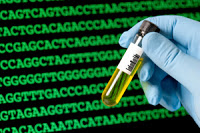Jennifer Lynch
EFF
In the amount of time it takes to get lunch, the government can now collect your DNA and extract a profile that identifies you and your family members.
The United Nations High Commissioner for Refugees (UNHCR) stated in a 2008 Note titled DNA Testing to Establish Family Relationships in the Refugee Context that DNA testing “can have serious implications for the right to privacy and family unity” and should be used only as a “last resort.” The UNHCR also stated that, if DNA is collected, it “should not be used for any other purpose (for instance medical tests or criminal investigations) than the verification of family relationships” and that DNA associated with the test “should normally be destroyed once a decision has been made.”
It seems USCIS is not heeding the UNHCR’s recommendations; the documents show that USCIS wants to use Rapid DNA analysis for much broader purposes than just verifying refugee applications. The agency notes that DNA should be collected from all immigration applicants—possibly even infants—and then stored in the FBI’s criminal DNA database. The agency also supports sharing immigrant DNA with “local, state, tribal, international, and other federal partners” including the Department of Defense and Interpol on the off-chance the refugee or asylum seeker could be a criminal or terrorist or could commit a crime or act of terrorism in the future. This flow chart shows USCIS’s ideal DNA collection and sharing process.
 Some federal agencies interested in Rapid DNA may not be able to implement it widescale for some time. Currently USCIS “does not have the authority to require DNA testing, even when fraud is highly suspected.” For that to happen, the agency would have to update 8 C.F.R. 204.2(d)(vi),1 which it has discussed doing but hasn’t yet done. And although the FBI is also very interested in Rapid DNA analyzers, legal rules prevent the Bureau from using the machines to process any DNA that wil go into its CODIS (Combined DNA Index System) database.
Some federal agencies interested in Rapid DNA may not be able to implement it widescale for some time. Currently USCIS “does not have the authority to require DNA testing, even when fraud is highly suspected.” For that to happen, the agency would have to update 8 C.F.R. 204.2(d)(vi),1 which it has discussed doing but hasn’t yet done. And although the FBI is also very interested in Rapid DNA analyzers, legal rules prevent the Bureau from using the machines to process any DNA that wil go into its CODIS (Combined DNA Index System) database.DHS’s own Science & Technology Division noted at a January 4, 2011 Working Group meeting that it was concerned “that prototype equipment may not provide totally reliable results.” Science & Technology staff stated they could not “yet predict how accurate the non-match findings will be, since the error rate for the machines remains unknown.” This means that people could be excluded from refugee programs just because the machine determined—inaccurately—that their DNA did not match their family member’s DNA.
DHS and USCIS acknowledge that “DNA collection may create controversy.” One USCIS employee advocated for “DHS, with the help of expert public relation professionals,” to “launch a social conditioning campaign” to “dispel the myths and promote the benefits of DNA technology.” Another document feared that “If DHS fails to provide an adequate response to [inquiries about its Rapid DNA Test Program] quickly, civil rights/civil liberties organizations may attempt to shut down the test program.”
However, the real issues with expanded DNA collection—and the issues these documents don’t answer—are whether DNA collection is really necessary to solve the challenges inherent in proving refugee entitlement to benefits; what standards and laws will govern expanded federal, state and local DNA collection and subsequent searches; how DNA will be collected, stored and secured; who will have access to it after it’s collected; and what processes are in place to destroy the DNA sample and delete data from whatever database it’s stored in after it’s served the limited purpose for which it was originally collected. Without answers to these questions, no amount of “social conditioning” can convince those concerned about privacy and civil liberties that expanded DNA collection is a good idea.
- 1. This regulation does not mention DNA testing and therefore cannot, without amendment, be used to establish a DNA testing requirement.
- 2. However, even the FBI’s procedures haven’t prevented fraud and abuse at labs. And as other USCIS documents note, according to the Department of State, security and chain of custody of the DNA sample have been issues in the past. Even “accredited labs are rife with problems.”
- 3. DNA.gov defines likelihood ratio as “The ratio of two probabilities of the same event under different hypotheses. In DNA testing often expressed as the ratio between the likelihood that a given profile came from a particular individual and the likelihood that it came from a random unrelated person. Note that in this case the likelihood of each event does not add to give 1 (100% likelihood) as it does not incorporate the possibility of error or that the profiles came from twins or other near relatives.”
linkwithin_text=’Related Articles:’



Be the first to comment on "Rapid DNA: Coming Soon to a Police Department or Immigration Office Near You"